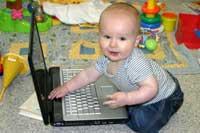“Calculations” of babies

More and more discoveries and news about the capabilities of babies. Some studies have recently come to confirm that during sleep they learn, clearly select toys or are able to distinguish what is right and wrong. On this occasion, however, scientists have come to the conclusion that they also have their own “mathematical skills” or at least are able to learn very early.
This is one of the main conclusions of a study conducted at Emory University in the USA. The journal Psychological Science has released this fact.
According to researchers, 9-month-old babies are sensitive to concepts like “more than” or “less than” in terms of number, size, and duration of objects. “Our discoveries, they said, indicate that human beings, from the first months of life, use quantity information to organize our experiences. Quantity seems to be a powerful tool to predict how objects should act.”
Looking at the images
To reach this conclusion, they showed babies images of different sets of objects on a computer screen. They measured the time they spent looking at objects to clarify how their brains processed the information presented. Spending more time on children may suggest that something surprises them.

Researchers showed babies on a computer screen a series of objects of different patterns to see their reaction. (Photo: Mark Evans.
Specifically, the study focused on analyzing the development of spatial perception. And both this and other cognitive dimensions such as numerical processing and time perception wanted to see how they interact with each other. “The human brain has statistical regularities, but it is not clear how it has achieved them; we wanted to see if they are achieved thanks to the experiences and linguistic associations that have been repeated over the years, or if, on the contrary, since childhood we have a generalized system of magnitudes,” they said. The results obtained seem to reinforce this second option.
In the experiment, they first showed them on the computer images of large black and striped objects and other whites and smaller types. Then they were shown more white and like objects than black and striped. And there they saw that the children spent more time and attention on white images than black ones. That is, they were surprised by this pattern, because they hoped that the larger (black) figures would also be the most numerous.

(Photo: Mykl Roventine.
The researchers say that “because they had broken the congruence they looked at the objects. They seem to expect a global correlation between these different dimensions.”
Based on this discovery, therefore, it is believed that human beings are born with a generalized system of magnitudes. “And if not,” they said, “we could say that we develop quickly.”
The research team believes that these results could also serve other future studies. They intend to continue investigating how we process quantitative information, both in normal and abnormal situations. And there are people who have difficulty understanding and performing mathematical operations, but they point out that so far this area has been analyzed little.
Published in 7K.
Buletina
Bidali zure helbide elektronikoa eta jaso asteroko buletina zure sarrera-ontzian











